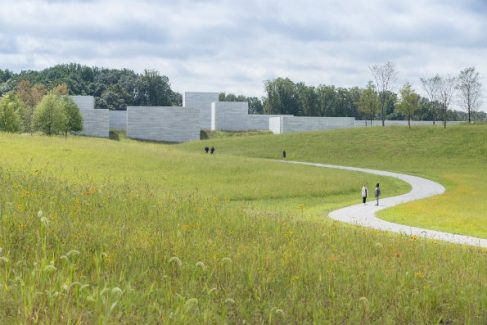After a $200 million expansion, the new and improved Glenstone museum in Potomac, Md. masters the art of relaxation through contemporary art.

Photos by Iran Baan, courtesy Glenstone Museum
As visitors to Glenstone make the seven minute walk from the parking lot to the private art museum’s freshly-launched Pavilions complex there are two words that subtly manifest– “chill out.” It turns out that the commute through the rolling green hills of Potomac, Md. was an intentional design element that represents founders Mitch and Emily Raleses’ ethos for their 230-acre art campus, a portion of which opened its doors late last year after a $200 million expansion. The distinctly different arrival exercise mentally and physically prepares visitors for the museum’s unique approach to experiencing art.
“We hope that you will slow down,” director and co-founder Emily Rales explained to media prior to opening, “and that your pulse will also slow down.”
Once inside, visitors are invited to enjoy the impressive showcase of post-World War II art in the same low-key manner and in tandem with a growing movement in the creative world called the “slow art” method. Through an advanced ticket reservation system that ensures the space is never overcrowded, a no photo policy and longer installation periods, the museum encourages visitors to check their haste (and social media) at the parking lot. “These types of artworks take time to understand and appreciate,” Emily says, further explaining that time is needed to “engage these complex works in the most profound way possible.”

She is referring to a priceless roster of works by contemporary greats, including Jasper Johns, Mark Rothko and Louise Borgeois, all of which are on display in pristine white gallery rooms sans traditional barriers. The collection reflects the couple’s commitment to progressive artists who “have altered the way we think about art–creating distinctive, often challenging bodies of work, and changing the course of art history,” Emily told Washington Life.
There is seamless flow between the property’s pristine landscape and modern architecture courtesy of Thomas Phifer and Partners and PWP Landscape Architecture– teams that spent years carefully crafting a setting that induces tranquility. A set of muted gray concrete buildings housing the collection feature long spacious corridors that commingle with massive skylights and windows to create a minimalist template that allows the bold and colorful pieces of avant-garde art to come alive. The galleries are anchored by a serene open-air courtyard complete with a pond filled with water lilies.

The Raleses drew inspiration for Glenstone from a range of art institutions across the globe including the Menil Collection in Houston and the Louisiana Museum of Modern Art in Denmark. From each of the nearly 50 private institutions they visited, the couple internalized ideas and moments that appropriately established a sense of place, noting those ideals as they designed the Pavilions complex—an expansion to the original museum, which opened in 2006.
Every detail was considered and centered on the idea that art should make you think and feel at the same time. “All of these features were designed to offer opportunities for meaningful and contemplative encounters with art, architecture and nature,” Emily says.

Art On Your Own Terms
In the galleries there are no didactics for artwork besides title, artist and year, leaving each piece open for personal interpretation and prompting visitors to engage with gray-clad guides, who are quietly stationed in the corner of each gallery. Many of them are part of Glenstone’s emerging professionals program, a two year commitment that was developed especially for recent graduates looking to pursue a career in the arts.
Glenstone | Open Thurs. – Sun. 10 a.m. to 5 p.m. | admission and parking free | glenstone.org
This article appeared in the February 2019 issue of Washington Life magazine.




